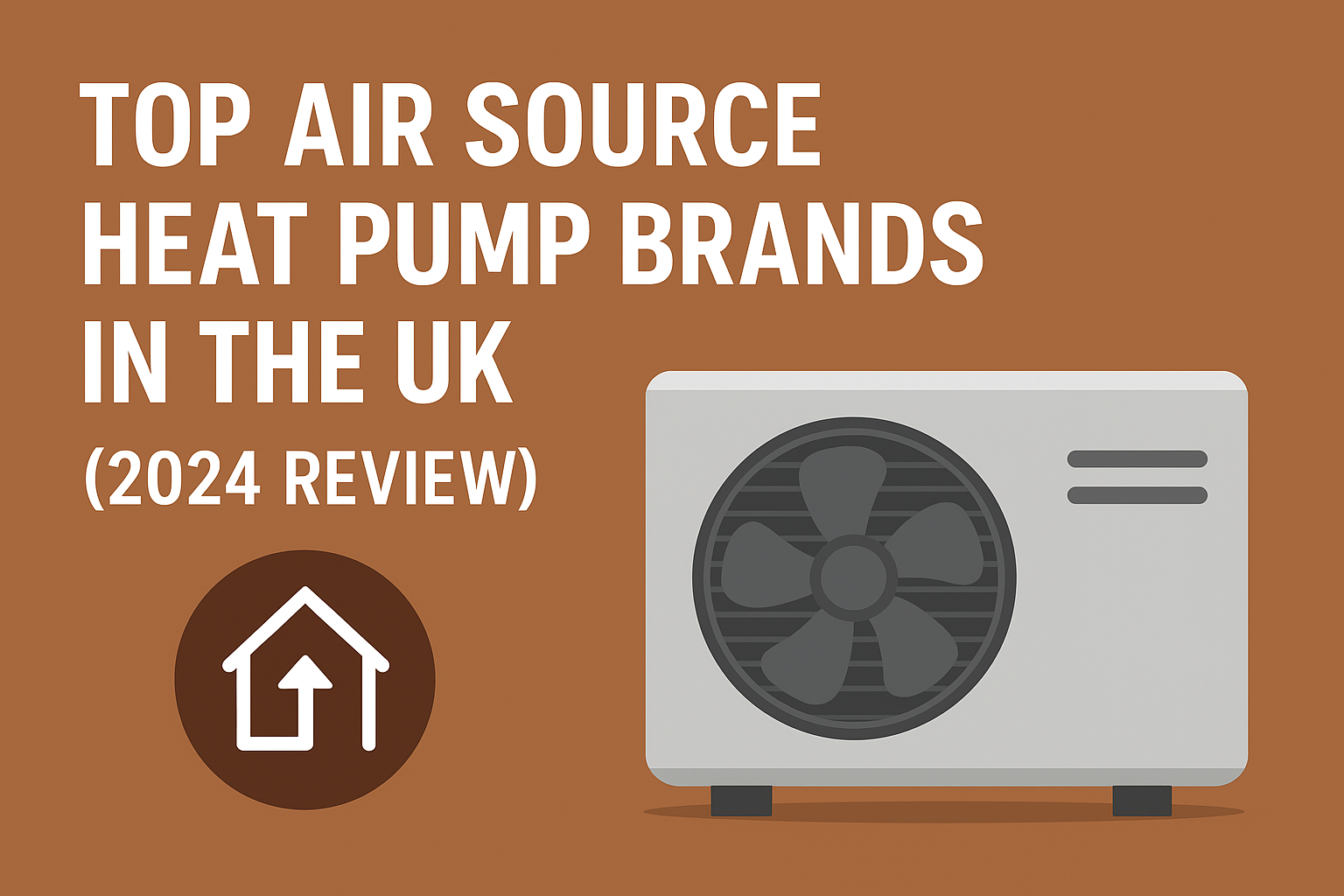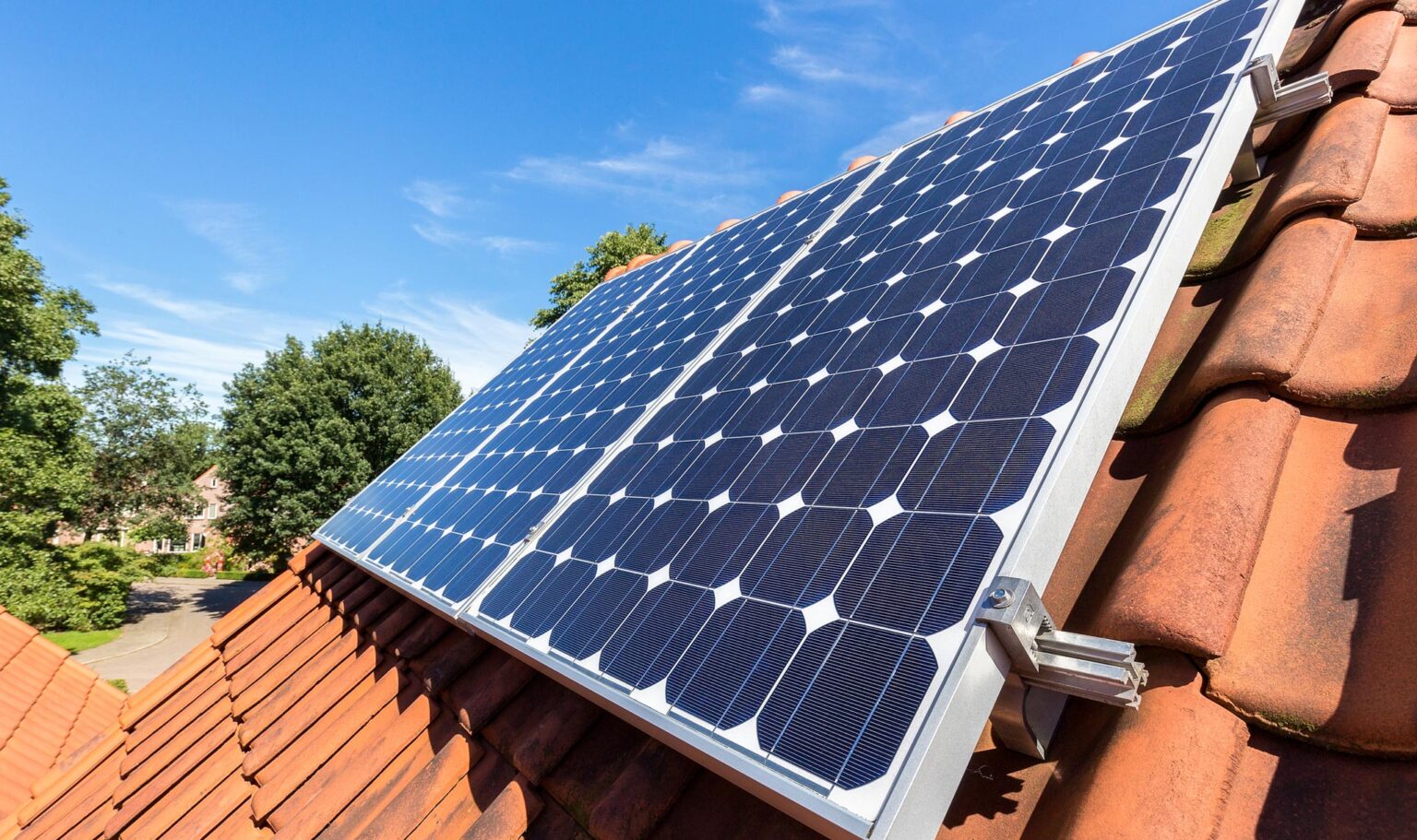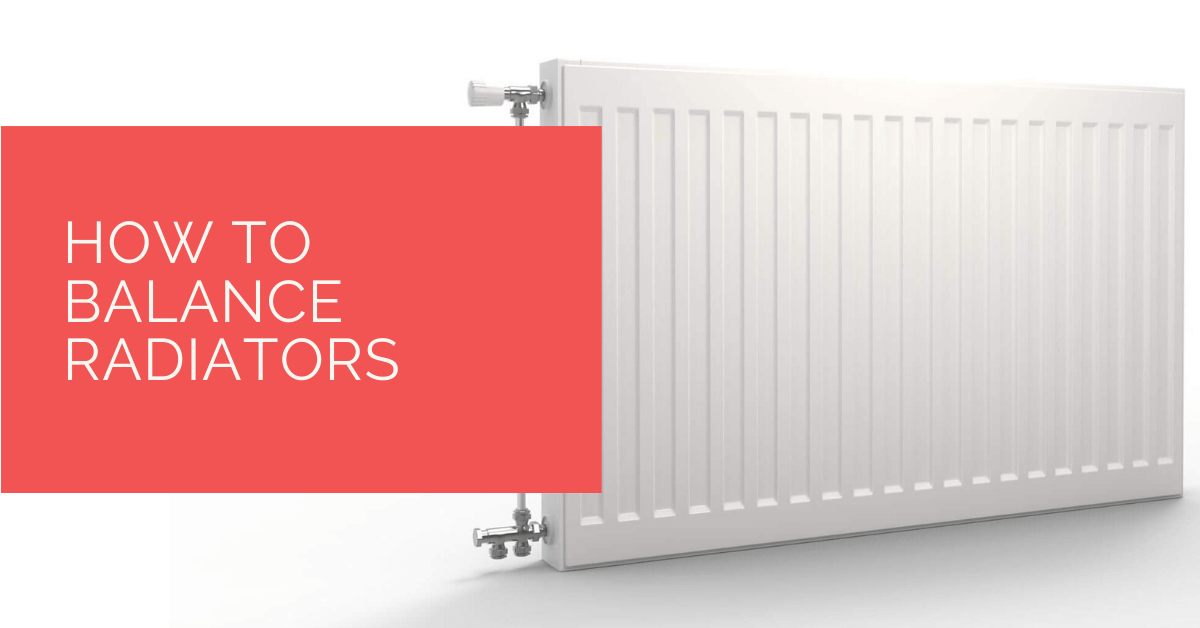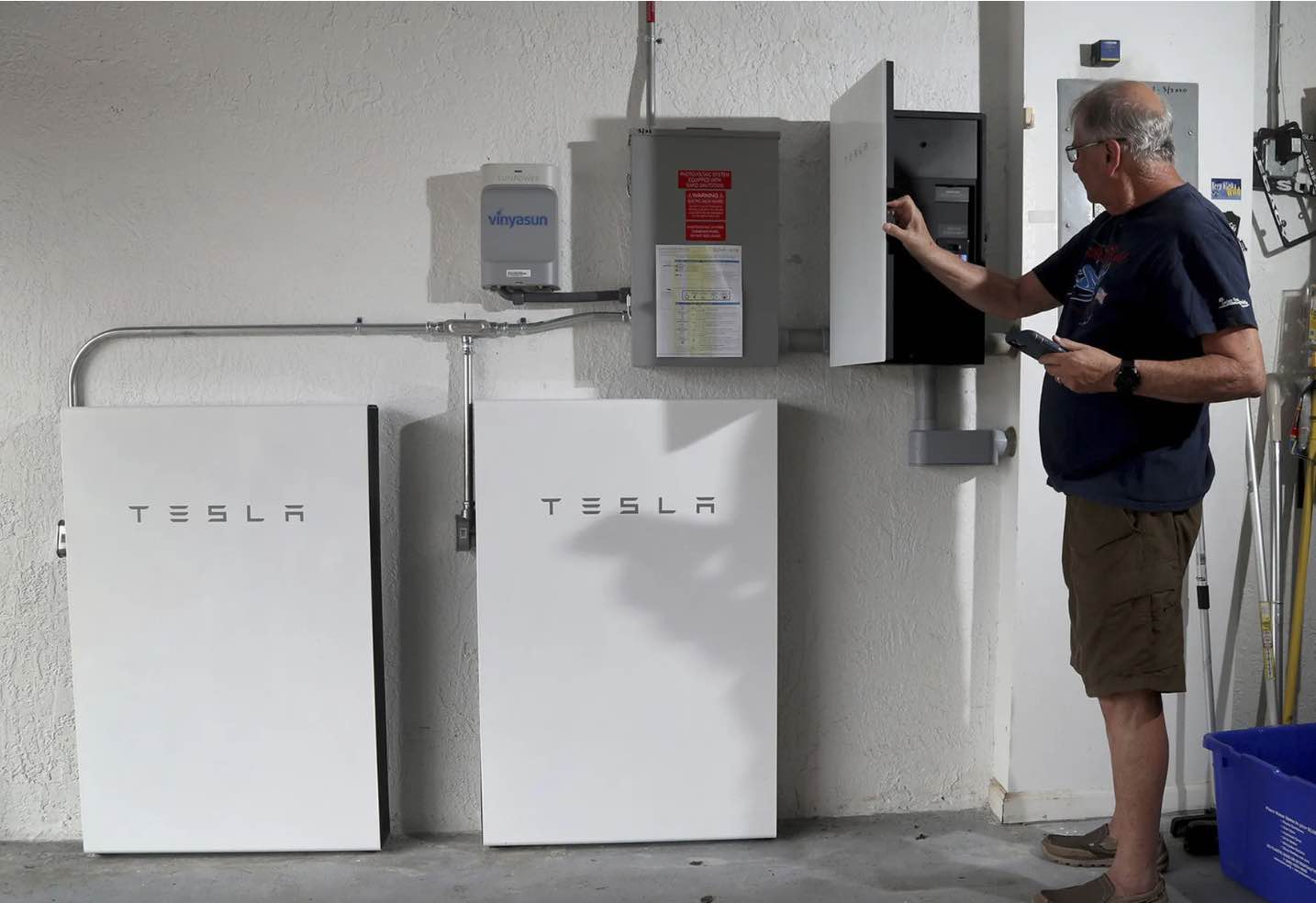Free Insulation Grants

Understanding Your Path to Free Home Insulation
If you’re among the UK householders watching your energy bills climb month after month, there’s genuinely good news waiting for you. Free insulation grants exist right now to help combat rising energy costs, and I’ve seen firsthand how these programs transform both homes and bank accounts. The Energy Company Obligation (ECO4) and Great British Insulation Scheme (GBIS) aren’t just government buzzwords—they’re real, tangible support systems launched in 2022 and 2023 respectively, designed to make your home warmer without emptying your wallet.
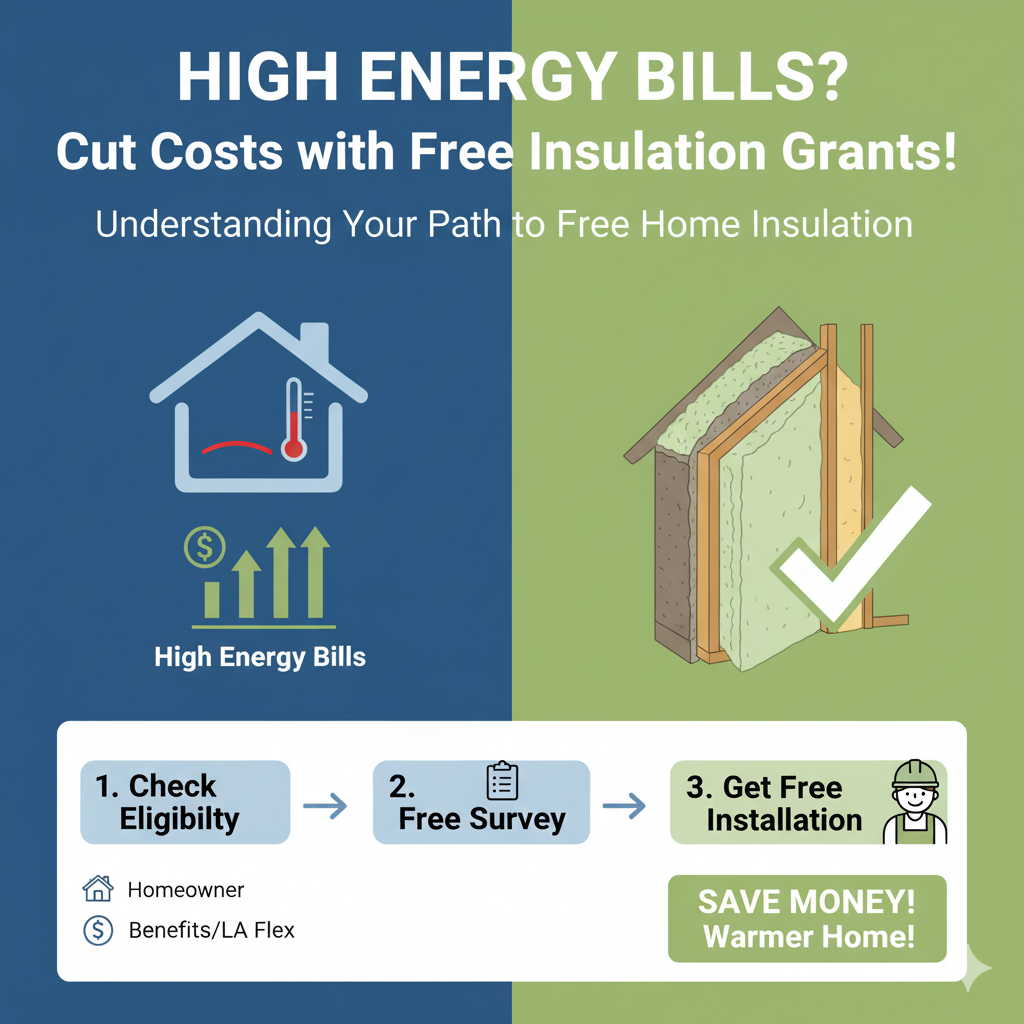
Here’s what makes this genuinely accessible: major energy suppliers are actually required to fund insulation for domestic households, focusing specifically on low income, fuel poor, and vulnerable individuals. The scheme aims to improve home heating efficiency while reducing carbon emissions and fuel poverty. As of February 10, 2025, an impressive 160,560 ECO4 projects have been submitted, proving this isn’t some future promise—it’s happening now. The current Government-backed energy efficiency scheme is running until March 2026, targets include helping to retrofit 300,000 homes with a substantial budget of £1 billion.
What I find particularly encouraging is how comprehensive the coverage is. Whether you need Cavity Wall Insulation, Internal Wall Insulation, Loft Insulation, Room in Roof Insulation, or External Wall Insulation, there are pathways to support. The eligibility framework prioritises households with EPC ratings of D, E, F, or G—particularly those with low incomes (earning less than £31,000 per year) or receiving means-tested benefits. But even if you don’t fall into these categories, the GBIS has extended support to households not on income-related benefits, opening doors for many more families.
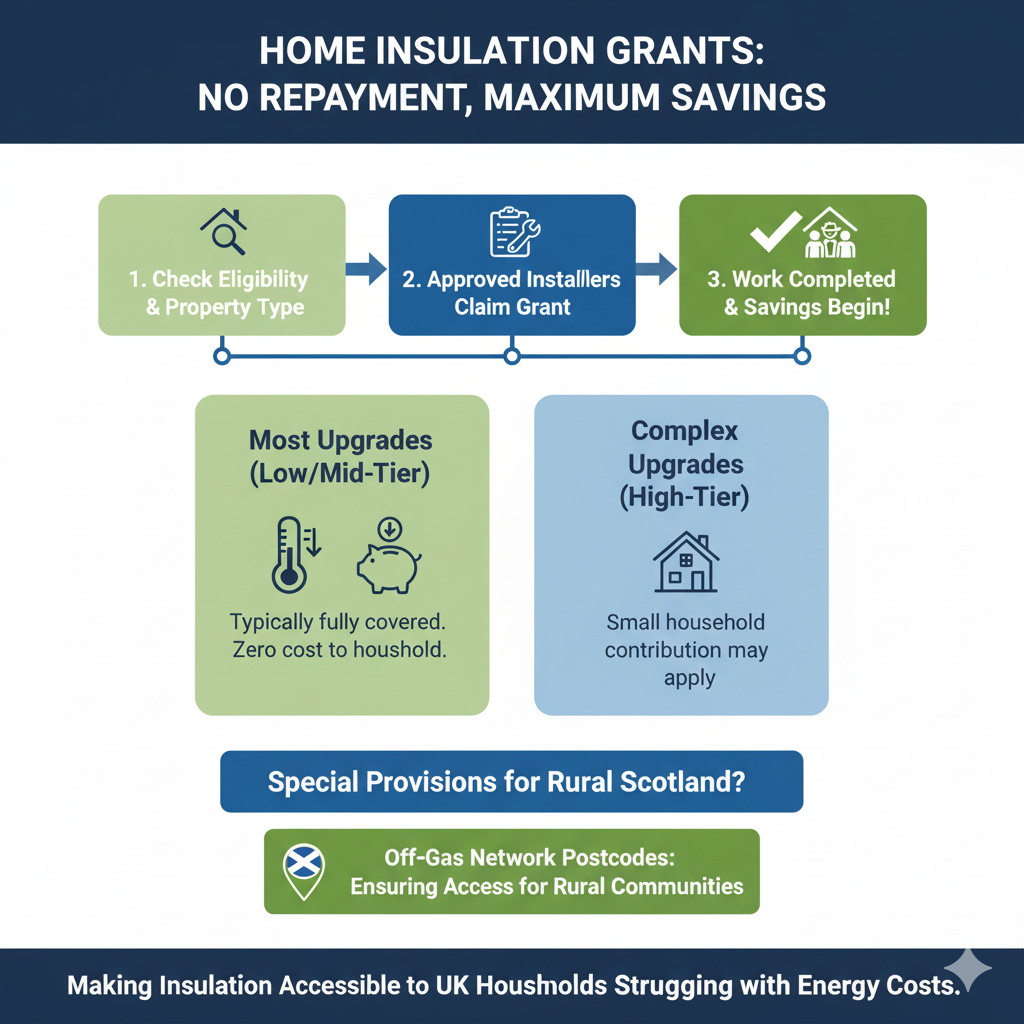
The structure is straightforward: Home Insulation Grants are completely non-repayable. Qualified applicants can have work completed by approved installers who claim the grant directly from the suppliers. Depending on your situation and property type, low tier upgrades and mid-tier upgrades are typically fully covered. Even complex high-tier upgrades might only require a small household contribution. Special provisions exist for properties in certain Scottish postcodes that are off the gas network, ensuring rural communities aren’t left behind. The amounts varying based on property characteristics, but the focus remains on making insulation accessible to those who need it most—the eligible specific criteria are designed to reach the widest possible audience of UK householders genuinely struggling with energy costs.
| Insulation Type | Typical Coverage | Best For |
| Cavity Wall Insulation | Fully covered | Properties built 1924-2005 with cavity walls |
| Loft Insulation | Fully covered | Homes with <100mm existing insulation |
| Internal Wall Insulation | Fully covered for mid-tier | Mid-terraced solid wall properties |
| External Wall Insulation | Varies by tier | Scottish postcodes (KW, IV, PH) off gas grid |
| Room in Roof Insulation | Fully covered | Converted lofts with fixed staircases |
What is New for 2025: The Warm Homes Local Grant
Something genuinely transformative launches on April 1st, and if you’ve been struggling with heating costs, this could be the game-changer you’ve been waiting for. The Warm Homes Local Grant arrives in 2025 with serious backing—we’re talking about allocating £500 million across 73 projects spanning 270 local authorities over the next three years. What strikes me most about this isn’t just the scale; it’s how the plan targets low-income households with EPC ratings from D to G, precisely the homes bleeding money through poor insulation and outdated heating systems. These are the families I’ve seen choosing between heating and eating, and this programme could genuinely significantly reduce energy bills across the UK.

Here’s where it gets really interesting: eligible households can access grants worth up to £15,000 for energy upgrades, plus an additional £15,000 specifically for low-carbon heating systems. That’s a potential £30,000 investment in making your home warm, efficient, and future-proof. And it doesn’t stop there—the Boiler Upgrade Scheme, which sits within the broader Warm Homes Plan, offers separate grants of up to £7,500 for heat pump installations. I’ve watched homeowners transform their properties with heat pumps, slashing their carbon footprint while actually improving comfort levels beyond what their old boilers ever achieved.
| Grant Component | Maximum Amount | What It Covers | Eligibility Focus |
| Warm Homes Local Grant – Energy Upgrades | £15,000 | Insulation, windows, ventilation | Low-income households, EPC D-G |
| Warm Homes Local Grant – Heating | £15,000 (additional) | Low-carbon heating systems | Same as above |
| Boiler Upgrade Scheme | £7,500 | Heat pump installations | Part of broader Warm Homes Plan |
| Total Potential Support | £30,000+ | Comprehensive home upgrades | 270 local authorities covered |

Which Benefits Qualify For Free Insulation?
The beauty of these programmes is their simplicity once you understand the basics: if someone living in your property receives any of the benefits listed below, you qualify for Cavity Wall Insulation, Internal Wall Insulation, Loft Insulation, and Room in Roof Insulation installed completely free of charge. I’ve worked with families who discovered they were eligible through benefits they’d been claiming for years—Child Tax Credit, Housing Benefit (note: not the single person’s 25% Council Tax reduction), Income-Based Jobseekers Allowance, Income-Related Employment Support Allowance, Income Support, Pension Credit Savings Credit, Pension Guarantee Credit, Universal Credit, Working Tax Credit, and Child Benefit. For that last one, limits apply based on your Combined annual household income (before tax and National Insurance). Even if your household isn’t in receipt of a qualifying benefit, you may still qualify if your annual household income is £31,000 or less, or through the Great British Insulation Scheme. With multiple schemes running and criteria for funding being admittedly complex, FreeInsulation will allocate you to a company that’s able to calculate which scheme is most appropriate to ensure you pay very little for energy efficiency measures—or get it for free.
What I appreciate about this system is its flexibility: even if you’re not entitled to a 100% free insulation grant, FreeInsulation can still put you in touch with an approved local Installer who can provide a competitive quote. The goal is making your home efficient, whether that’s fully funded or subsidised—nobody gets turned away without options.
| Qualifying Benefits | Income Threshold | Coverage Type |
| Universal Credit, Income Support, Pension Guarantee Credit, Income-Based JSA/ESA | Any income level | 100% free installation |
| Child Tax Credit, Working Tax Credit, Housing Benefit | Income limits apply | 100% free installation |
| Child Benefit | Combined household income limits | 100% free installation |
| No benefits claimed | £31,000 or less annual household income | May qualify via GBIS |
| Above income thresholds | Over £31,000 annually | Subsidised quotes available |
How It Works
Cavity Wall Insulation Grants:
The straightforward truth is that all householders in receipt of a qualifying benefit can claim a 100% free Cavity Wall Insulation Grant, provided your property is occupied and not under renovation. What many people don’t realize is just how many homes qualify based purely on when they were constructed. Properties built of brick between 1924 and 1982 are generally suitable for Cavity Wall Insulation—that’s nearly six decades of housing stock that could benefit immediately. I’ve assessed countless period homes where owners assumed their solid-looking walls couldn’t be insulated, only to discover they had perfectly good cavities just waiting to be filled. The building industry shifted dramatically during this era, moving from solid wall construction to cavity designs, which means if your home falls within this timeframe, there’s an excellent chance you’re sitting on an opportunity to slash your heating bills.
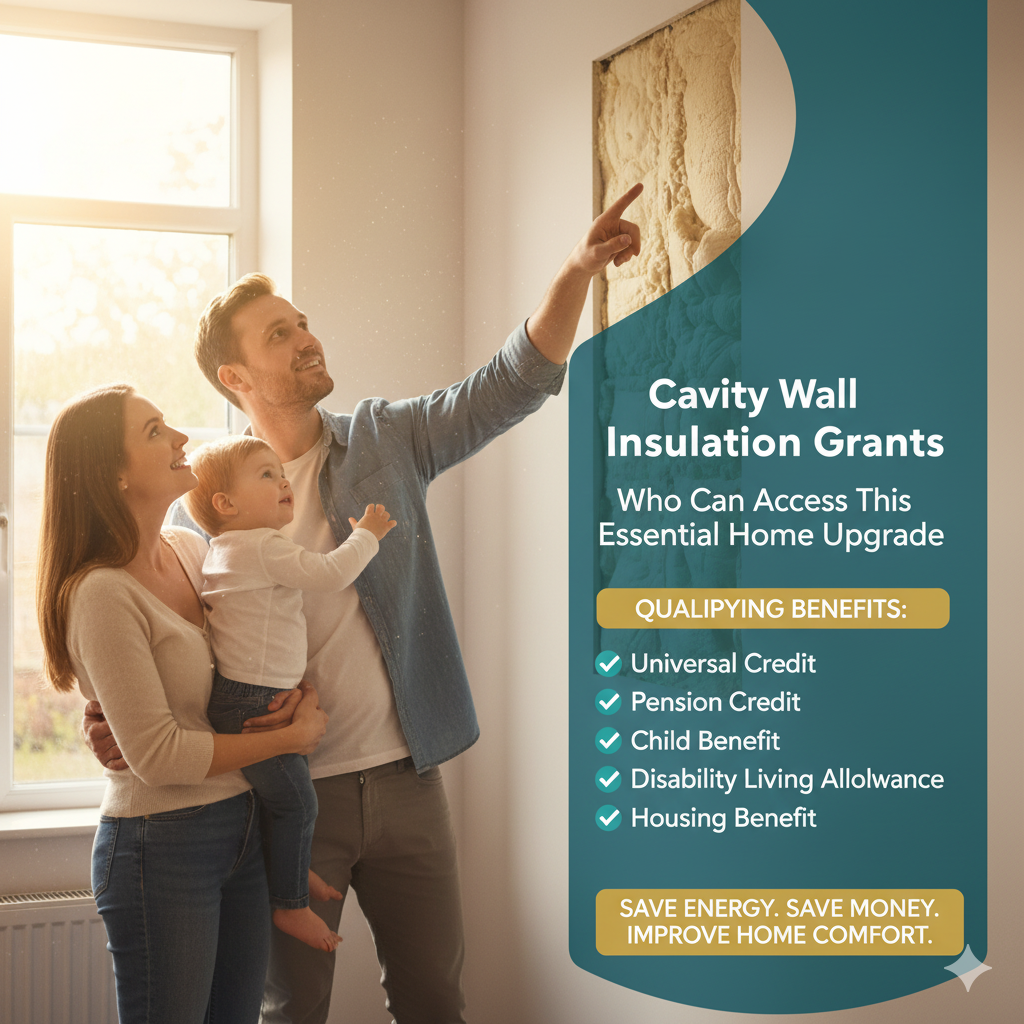
Here’s what makes this particularly accessible: the programme doesn’t just stop at the 1982 cutoff. We can help with properties that were built up to 2005 without insulation—a surprisingly common scenario where developers either skipped insulation entirely or installed substandard materials that have since degraded. The process is remarkably simple once eligibility is confirmed, and the transformation is immediate. Properly installed cavity wall insulation can cut heat loss through walls by up to 35%, which translates directly to warmer rooms and lower energy bills. The work typically takes just a day or two, with minimal disruption, and once those cavities are filled with modern insulating material, you’ll notice the difference every single winter for decades to come.
| Property Build Period | Wall Construction | Suitability for Cavity Wall Insulation | Grant Coverage |
| 1924-1982 | Brick cavity walls | Generally suitable | 100% free for qualifying households |
| 1983-2005 | Brick cavity walls (if uninsulated) | Suitable with assessment | 100% free for qualifying households |
| Pre-1924 | Typically solid walls | Not suitable for cavity wall insulation | Alternative grants available (IWI/EWI) |
| Post-2005 | Usually pre-insulated | Assessment required | Case-by-case basis |

Loft Insulation Grants
Whether your property is owned or rented, as long as it’s currently occupied and not under renovation, you’re in the running for support that could transform your home’s heat retention. If you currently receive any of the benefits listed in the qualifying criteria, you’re entitled to a 100% grant for loft insulation—but here’s the critical measurement that determines everything: you need 100mm (4 inches) or less of insulation already installed to qualify for the full grant. I’ve climbed into hundreds of lofts where homeowners had no idea how little insulation they actually had—what typically looks like adequate coverage is often barely at level with or below the joists, leaving massive amounts of heat escaping through the roof. That visual check is simple: if you can clearly see the tops of your joists, you’re losing money every single day your heating is on.
Now, if your insulation sits above this level, don’t assume you’re out of options. We can still arrange a free survey and provide a quote to top up your existing insulation to the current recommended standard of 270mm—that’s roughly 11 inches of protective material between your living space and the cold outside. The difference between minimal insulation and proper coverage isn’t marginal; it’s transformative. Heat rises, and an inadequately insulated loft is essentially an open door to the sky. Bringing your loft up to 270mm can reduce heat loss by up to 25%, which means your boiler works less, your rooms stay warmer, and your bills drop noticeably. The installation is quick, non-invasive, and the benefits compound year after year.
| Current Insulation Depth | Visual Indicator | Grant Eligibility | Recommended Action |
| 0-100mm (0-4 inches) | At or below joist level | 100% free grant for qualifying households | Full installation to 270mm |
| 100-270mm (4-11 inches) | Above joist level | Free survey available | Top-up to 270mm (quote provided) |
| 270mm+ (11+ inches) | Well above joists | Assessment required | Case-by-case evaluation |
Key Measurement Guide:
- Below joists = Urgent need, maximum grant available
- Level with joists = Still qualifies for full grant
- Above joists = Partial upgrade options available
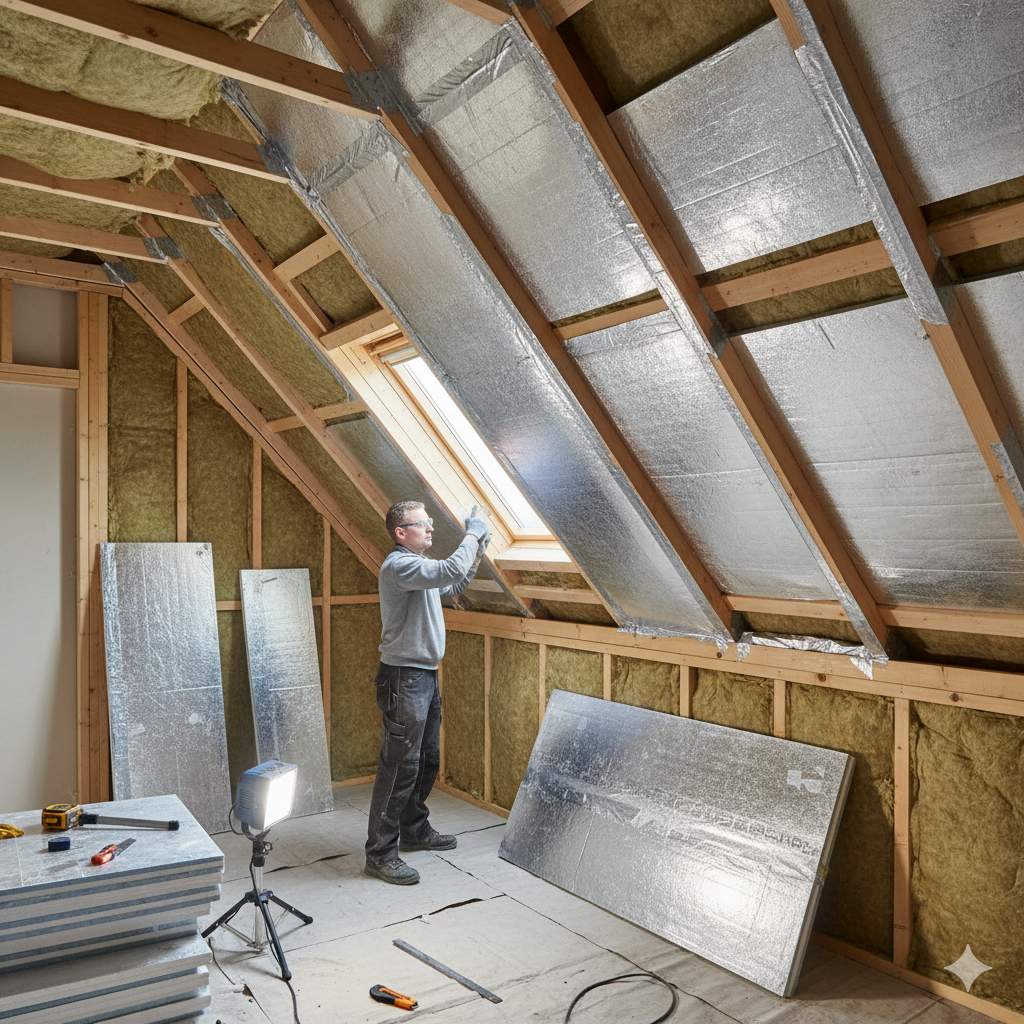
Room In Roof Insulation Grants
If you’re in receipt of a qualifying benefit as listed in the eligibility criteria, you should receive Free Room In Roof Insulation without any out-of-pocket expense—but even if you not qualify for the full room in roof insulation grant, we can still arrange for an approved installer to give you a competitive quote for the work. What makes this particular grant unique is its focus on a specific type of space that many homeowners overlook: your property must have been constructed with roof rooms or feature a loft conversion where there’s currently little or no insulation in the walls and ceiling. I’ve visited countless homes where families converted their lofts years ago, creating beautiful extra bedrooms or offices, only to find these spaces unbearably cold in winter and stifling in summer because the insulation was either never installed or has deteriorated significantly.
The technical requirements are straightforward but important: a fixed staircase must be present—not a pull-down loft ladder or anything similar—which distinguishes a proper habitable room from basic loft storage. Whether you’re a homeowner or tenant, you can qualify as long as the space meets these structural criteria. The transformation after proper insulation is remarkable; these rooms shift from being barely usable seasonal spaces to comfortable, year-round living areas that actually add value to your home. The insulation wraps around the sloped ceilings and vertical walls, creating a thermal envelope that keeps heat where it belongs and dramatically reduces the workload on your heating system.
| Eligibility Criteria | Requirement | Why It Matters |
| Property Type | Constructed with roof rooms OR completed loft conversion | Defines habitable space vs. storage |
| Current Insulation | Little or no insulation in walls & ceiling | Determines improvement potential |
| Access Type | Fixed staircase present | Must NOT be pull-down loft ladder or similar |
| Occupancy Status | Homeowner or tenant | Both qualify for grants |
| Benefit Status | In receipt of qualifying benefit | Unlocks 100% free installation |
Internal Wall Insulation Grants
Tackling Solid Wall Heat Loss from the Inside
If your household claims a qualifying benefit, you may be eligible for free or subsidised Internal Wall Insulation—a game-changer for older homes where heat literally seeps through the brickwork. Your property must have solid walls and be either owned or rented (though tenants will need landlord permission before work begins). The Additional eligibility criteria layer on from there: you’ll need an EPC rating of D or below (or E for renters), Household income under £31,000/year, and your home must fall within Council Tax bands A-D in England or A-E in Scotland and Wales. Currently, grants are only available for mid-terraced properties—a targeting decision based on where the technology delivers the most impact per pound spent. I’ve worked with families in Victorian terraces who lived with cold, damp walls for years, assuming nothing could be done without massive expense, only to discover they qualified for full funding.
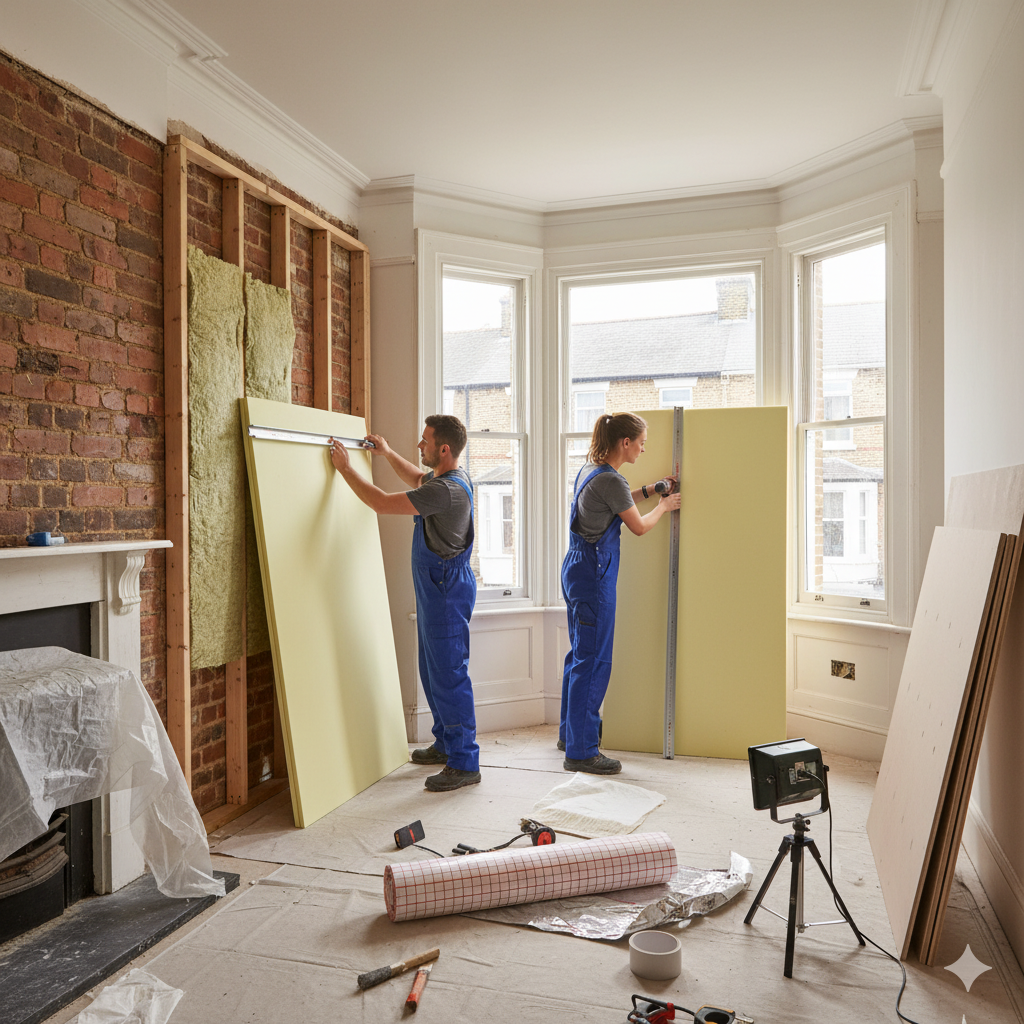
Installing Internal Wall Insulation can save up to £360 annually on energy bills for these homes, which compounds to thousands of pounds over the insulation’s lifespan. Even if you don’t qualify for a full grant, we can arrange a free survey and competitive quote to make the work affordable. Either way, a free, no-obligation survey is required to confirm eligibility and assess your property’s suitability—solid walls vary enormously in condition, and factors like damp, electrical layouts, and room dimensions all influence the installation approach. The process involves fixing insulated boards to interior walls, then replastering, which does reduceroom size slightly (typically by 10-15cm per wall), but the comfort improvement is immediate and dramatic. Rooms feel warmer at lower thermostat settings, condensation issues often disappear, and the cold-to-the-touch sensation of solid walls becomes a thing of the past.
| Eligibility Factor | England | Scotland & Wales | All Regions |
| Council Tax Band | A-D | A-E | Must meet this criterion |
| EPC Rating (Owners) | D or below | D or below | Lower ratings prioritized |
| EPC Rating (Renters) | E or below | E or below | Slightly relaxed for tenants |
| Household Income | Under £31,000/year | Under £31,000/year | Before tax |
| Property Type | Mid-terraced | Mid-terraced | Currently the only eligible type |
| Wall Construction | Solid walls | Solid walls | No cavity present |
| Potential Annual Savings | £360 | £360 | On energy bills |
Key Requirements Summary:
- ✓ Solid wall construction (no cavity)
- ✓ Mid-terraced position
- ✓ Owner-occupied or rented (with landlord consent)
- ✓ Qualifying benefit claimed OR income under £31,000
- ✓ Free survey confirms suitability
External Wall Insulation Grants
Premium Insulation Solutions for Rural and Solid Wall Properties
The reality is that External Wall Insulation costs typically range from £6,000 to £30,000 depending on property size and complexity—which puts it out of reach for most families without support. That’s where FreeInsulation steps in to arrange a free survey and quote from an accredited installer, unlocking opportunities that would otherwise remain financially impossible. Free insulation is particularly available for residents in KW, IV, or PH postcodes who are without mains gas—a targeted intervention for rural Scottish communities where heating costs run astronomically high and alternative solutions are desperately needed. The technology is suitable for solid brick or concrete walls, though it’s unsuitable for properties with cavity walls (which have their own, less expensive insulation options).
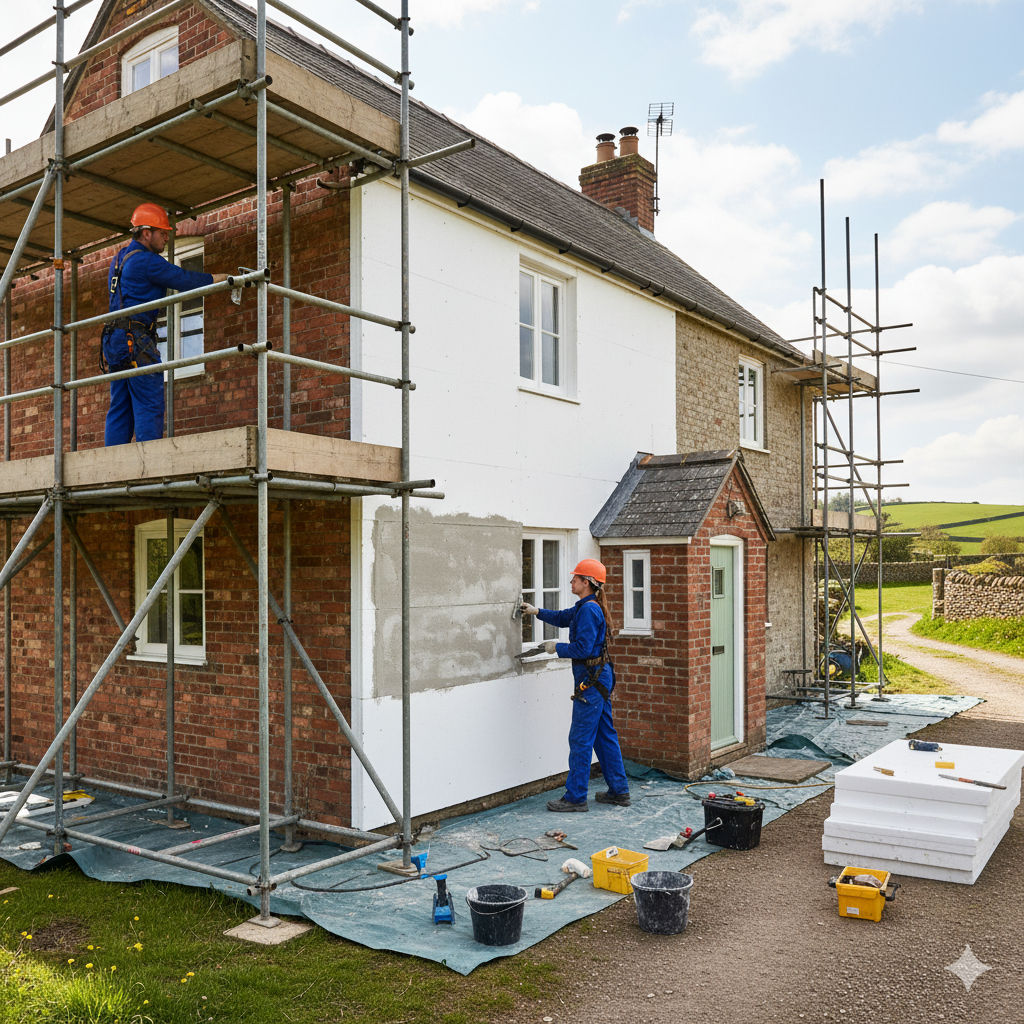
The Eligibility criteria mirror other schemes: Household income under £31,000/year, an EPC rating of D or below (or E for renters), and falling within Council Tax bands A-D in England or A-E in Scotland and Wales. What makes external wall insulation particularly appealing—beyond the dramatic kerb appeal transformation—is the performance. Installation can save up to £360 annually on energy bills, but the real magic is in how it completely reimagines your home’s thermal performance. I’ve seen stone cottages in the Highlands go from bone-chillingly cold with constant condensation to warm, dry, comfortable homes where a single woodburner can heat the entire ground floor. The insulation wraps the building like a winter coat, protecting the masonry from weather damage while eliminating thermal bridging and cold spots that traditional heating systems struggle to overcome.
| Cost & Eligibility Overview | Details |
| Typical Cost Range | £6,000 – £30,000 (without grant support) |
| Priority Postcodes | KW, IV, PH (Scottish rural areas) |
| Heating Type Requirement | Without mains gas connection |
| Suitable Wall Types | Solid brick, concrete walls |
| Unsuitable For | Cavity walls (use cavity wall insulation instead) |
| Household Income Limit | Under £31,000/year |
| EPC Rating (Owners) | D or below |
| EPC Rating (Renters) | E or below |
| Council Tax Bands | A-D (England) / A-E (Scotland & Wales) |
| Annual Energy Bill Savings | Up to £360 |
Geographic Focus:
- KW Postcodes: Caithness, Sutherland, Orkney
- IV Postcodes: Inverness-shire, Ross-shire
- PH Postcodes: Perthshire, parts of Highlands
Free Insulation Grant FAQs
Everything you need to know about getting free insulation through ECO4 and GBIS schemes
Yes, absolutely. Homeownership doesn’t disqualify you—what matters is whether you receive qualifying benefits or have a household income under £31,000 per year. The ECO4 scheme specifically targets homeowners and tenants alike, focusing on energy efficiency improvements regardless of mortgage status.
Tenants can apply directly for most insulation types, but you’ll need your landlord’s permission before work begins. The application process is straightforward, and many landlords welcome the improvements since better insulation increases property value and reduces complaints about cold homes. The grant covers the cost entirely, so there’s no financial burden on either party.
ECO4 primarily targets low-income households and those receiving means-tested benefits, with no household contribution required in most cases. GBIS, launched in 2023, extends support to middle-income households (earning up to £31,000) who don’t claim benefits. Both schemes run until March 2026, and FreeInsulation automatically assesses which scheme suits your circumstances best.
It varies by insulation type: cavity wall and loft insulation typically take 1-2 days with minimal disruption. Internal wall insulation takes 1-2 weeks per room due to plastering and drying time. External wall insulation is the most extensive, usually requiring 2-4 weeks depending on property size. Room in roof insulation falls somewhere in the middle at 3-5 days.
For qualifying households, there are genuinely no upfront costs—the installer claims the grant directly from energy suppliers. However, a free survey is required first to confirm eligibility and assess your property. In some cases involving complex, high-tier upgrades (particularly external wall insulation in non-priority areas), you might be asked for a small household contribution, but this is disclosed clearly before any work begins.
Unfortunately, ECO4 prioritizes homes with EPC ratings of D, E, F, or G, as these properties lose the most heat and have the highest energy bills. If your rating is C, you likely won’t qualify for free insulation, though you can still request a quote from approved installers for subsidized work. The focus is on bringing the worst-performing homes up to acceptable standards first.
Yes, if your existing insulation measures 100mm (4 inches) or less, you qualify for a free upgrade to the recommended 270mm depth. Even if your insulation sits above 100mm, you can arrange a free survey and quote to top it up. Many homes installed insulation decades ago that’s now compressed or inadequate by modern standards.
Mid-terraced properties with solid walls currently qualify for Internal Wall Insulation grants under ECO4. This involves fitting insulated boards to interior walls and replastering, which slightly reduces room size but dramatically improves warmth. External Wall Insulation is generally reserved for specific Scottish postcodes (KW, IV, PH) where properties are off the gas network, unless you’re willing to pay privately.
Savings depend on insulation type and your current setup: cavity wall insulation can save around £260-£310 annually, loft insulation saves approximately £355 per year, and internal or external wall insulation can save up to £360 annually. These figures assume typical usage patterns and a home previously lacking insulation. Combined measures can reduce bills by £500-£800+ per year.
The Warm Homes Local Grant launches April 1st, 2025, offering up to £15,000 for energy upgrades plus an additional £15,000 for low-carbon heating systems like heat pumps. It targets low-income households with EPC ratings D-G across 270 local authorities. You can potentially combine this with the Boiler Upgrade Scheme (£7,500 for heat pumps) and ECO4 insulation grants for a comprehensive home transformation—FreeInsulation will help determine the best package for your situation.
Latest Insights & Guides
Top Air Source Heat Pump Brands in the UK (2025 Review)
Introduction With rising energy bills and the UK’s push toward net-zero carbon…
Solar Panel Systems: Your Complete Guide to Grant-Backed Renewable Energy Solutions
Solar panel systems have revolutionized how homeowners approach energy consumption, offering a…
TRV – How Thermostatic Radiator Valves Improve Heating Efficiency in 2025
Introduction Homeowners in the UK are increasingly looking for ways to reduce…
How Do You Balance Radiators? Step-by-Step Guide for Efficient Heating
When your central heating isn’t working as it should—some rooms feel too…
Tesla Powerwall 3 Price for ECO4 – What UK Homeowners Need to Know
Introduction The Tesla Powerwall 3 is one of the most advanced home…
Retrofit Assessments – A Complete Guide for UK Homeowners in 2025
Introduction With rising energy costs and growing concerns about climate change, more…
